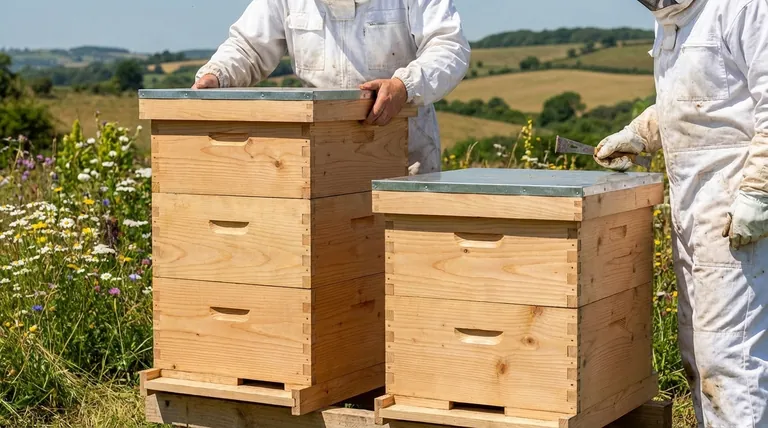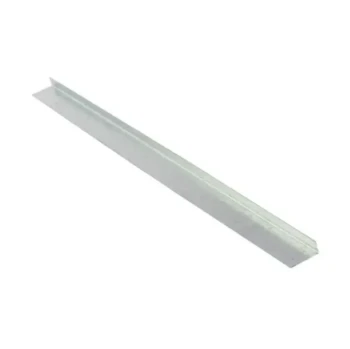The fundamental difference between 8-frame and 10-frame beehives is a direct trade-off between weight and space. An 8-frame hive is narrower and its boxes are significantly lighter to lift, making it more manageable for the beekeeper. A 10-frame hive offers more interior space for bees and honey storage but comes with the challenge of substantially heavier boxes.
The choice is not about which hive is definitively "better," but about which system best aligns with your physical capabilities, beekeeping goals, and local climate. Understanding these core trade-offs is the key to making the right decision for your apiary.

The Beekeeper's Experience: Weight vs. Height
The most immediate difference you will feel as a beekeeper is in the physical handling of the equipment. This single factor often becomes the deciding one.
The Challenge of Weight (10-Frame)
A 10-frame deep hive body, when full of brood, pollen, and honey, can weigh upwards of 80-90 pounds (36-41 kg).
This significant weight makes lifting boxes during hive inspections a major physical challenge, especially for those with back problems or limited strength.
The Challenge of Height (8-Frame)
In contrast, a full 8-frame deep box typically weighs around 60-70 pounds (27-32 kg), a much more manageable load.
However, because each box holds less, a strong colony in an 8-frame system will require more boxes stacked vertically to provide the same total volume. This can result in a taller, more precarious hive.
The Bees' Perspective: Space and Winter Survival
Beyond the beekeeper's convenience, the hive's internal dimensions have a direct impact on the colony's health and natural behavior.
A More Natural Shape (8-Frame)
The narrower, more vertical configuration of an 8-frame hive more closely mimics the hollow trees that wild honeybees naturally colonize.
This shape encourages the bees' instinct to build upwards, and they tend to fill the frames more completely before moving to the next box.
Surviving the Cold (8-Frame Advantage)
The compact nature of an 8-frame box is a significant advantage in cold climates.
The smaller space is easier for the bees' winter cluster to keep warm. It also ensures the cluster can more easily stay in contact with its honey stores as it moves through the hive during winter.
Room to Grow (10-Frame Advantage)
The primary benefit of a 10-frame hive for the bees is the sheer amount of uninterrupted space in each box.
This provides the queen with more room to lay eggs and allows the colony to store larger quantities of honey in a single super, potentially delaying the need for the beekeeper to add another box.
Understanding the Trade-offs
Choosing a hive system involves balancing several competing factors, from cost and convenience to the overall productivity of the hive.
Honey Production Potential
A 10-frame hive holds 25% more volume per box, which can translate to higher honey yields with fewer boxes.
However, a well-managed 8-frame hive can be just as productive; it will simply require more boxes and potentially more frequent monitoring to prevent the colony from running out of space.
Equipment Availability and Cost
The 10-frame Langstroth hive is the traditional industry standard in North America. This means equipment is widely available from nearly all suppliers.
8-frame equipment is also very common but may be slightly less available from some smaller retailers. The boxes and components are typically a little cheaper than their 10-frame counterparts.
Tipping Hazard
The taller, narrower profile of a stacked 8-frame hive makes it more susceptible to being tipped over by strong winds or animals.
This requires a very stable and level hive stand, and some beekeepers choose to strap their hives for added security, especially in windy locations.
Making the Right Choice for Your Apiary
Ultimately, your decision should be based on a realistic assessment of your goals and physical limitations.
- If your primary focus is minimizing heavy lifting: The 8-frame system is the clear winner, protecting your back during hive inspections.
- If your primary focus is maximizing honey storage per box: The 10-frame system provides more space and is the traditional commercial standard.
- If you live in a region with very cold winters: The 8-frame hive's narrower dimensions offer a thermal advantage for the colony.
- If you are unsure or value standardization: The 10-frame hive has the widest availability of compatible equipment.
Choosing the right hive is the first step in creating a sustainable beekeeping practice that works for both you and your bees.
Summary Table:
| Feature | 8-Frame Hive | 10-Frame Hive |
|---|---|---|
| Weight (Full Deep Box) | ~60-70 lbs (27-32 kg) | ~80-90 lbs (36-41 kg) |
| Space per Box | Less | 25% More |
| Winter Survival | Better (easier to keep warm) | Standard |
| Ideal For | Beekeepers prioritizing ease of lifting, cold climates | Maximizing honey storage per box, traditional standard |
Ready to Equip Your Apiary with the Right Hive System?
Whether you manage a large commercial apiary or supply beekeeping equipment to distributors, choosing the right hive is critical for success. HONESTBEE supplies high-quality, durable 8-frame and 10-frame beehives and equipment through our wholesale-focused operations.
We provide the reliable supplies you need to build a sustainable and productive beekeeping practice.
Contact us today to discuss your needs and get a quote: Get in Touch
Visual Guide

Related Products
- Langstroth Bee Hives Bee Keeping Box for Beginners Beekeeping
- Professional Insulated Plastic Bee Hives
- Long Langstroth Style Horizontal Top Bar Hive for Wholesale
- Wholesales Dadant Size Wooden Bee Hives for Beekeeping
- Professional Galvanized Hive Strap with Secure Locking Buckle for Beekeeping
People Also Ask
- Why are Langstroth hives recommended for beginners? Unmatched Support & Standardization
- Should a beginner try a different type of hive? Start with a Langstroth for a solid foundation.
- What are the different types of beehive boxes available? Choose the Right Hive for Your Apiary
- Why were wooden hives traditionally preferred? For Natural Beekeeping Aligned with Bee Biology
- How does the ease of access differ between 8-frame and 10-frame hives? Choose the Right Hive for Your Body



















